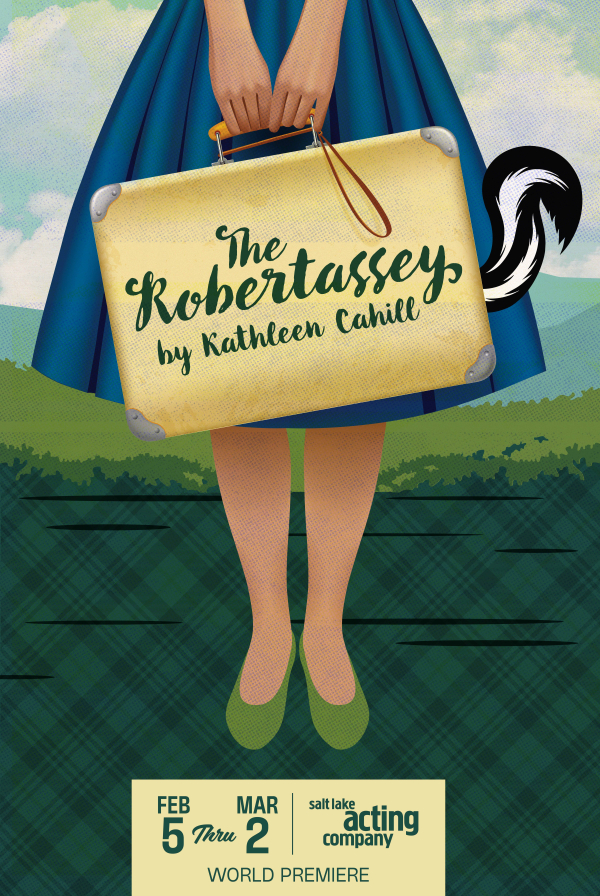SLAC’s “Surely Goodness and Mercy” is Surely More Than Merely Good
Front Row Reviewers | By Suzanna Whitman | September 7, 2017
Salt Lake Acting Company is known for its thought-provoking theatre, and their production of Chisa Hutchinson’s new play Surely Goodness and Mercy is no exception. The play is part of the National New Play Network’s rolling premiere program, which mounts several productions of the same new play at theatres across the nation.
According to the narratives all around us, benevolent white people are always swooping in to save poor Black people. But playwright Hutchinson knew that in reality, poor Black people are pretty darn good at solving their own problems. When she was commissioned to write Surely Goodness and Mercy, the only criteria she was given was that it “had to be relevant to New Jersey in some way.” So she created the story of Tino (Clinton Bradt, Devin Losser), a recently orphaned 12-year-old boy and Bernadette (Yolanda Wood Stange), the lunch lady at his school, and the unlikely friendship they form. As they encounter struggles of home and health, the two find ways to help each other through.
Hutchinson’s moving script feels like a movie. The story is told in short scenes and moments, and Alicia Washington’s direction (with assistance from Dee-Dee Darby Duffin) embraces this cinematic feeling. The entire production feels lyrical, from the sound to the lighting to the acting.
As the awkward, Bible-toting Tino, Bradt is perfect. Bradt’s performance is endearing, and his body language was especially expressive—he perfectly captures the awkwardness of someone who is no longer a child but not yet a man, who has too much integrity to be anything but himself, even if it makes him an outsider. (The role of Tino is double cast, with Bradt and Losser trading off nights.)
Stange is positively electric as the cantankerous Bernadette. But her salty exterior falls away in poignant moments to reveal a woman who both hurts, and who is strong in the face of that hurt. Her performance is riveting, even in the silent moments when she is simply clearing away lunch trays or turning off her alarm clock.
Tino’s cruel aunt Alneesa is played by Michelle Love-Day. But her cruelty isn’t vindictive—Love-Day’s performance makes it clear that this is a woman who has worked hard all her life and never gotten far enough. Her meanness is born of the kind of pain and weariness that a lifetime of dealing with poverty and racism can create. Love-Day’s performance as Alneesa is balanced by humor, making her a sympathetic character.
Jenna Newbold plays Deja, a fellow middle-school student who befriends Tino. (The role is also double-cast, with Kiara Riddle.) Newbold is funny and strong, and her own cantankerous moments are softened by her obvious affection for Tino. The character of Deja walks the line between wanting to belong in the world of middle school, and wanting to be appreciated for exactly who she is. Newbold balances those sometimes conflicting desires with honesty.
Voiceover provided by Bijan Hosseini (Principal), James Jamison (Preacher), and Sammee Lydia James (Teacher) was wonderful. It’s difficult to create an entire character by voice alone, and each actor brought life and honesty to their characters.
The show is being performed in Salt Lake Acting Company’s smaller venue, the Chapel Theatre. The audience is arranged in six rising rows, surrounding three quarters of the set. Seating is general, but there isn’t a “bad” seat in the house. Thomas George’s set design (with the assistance of Megan Branson), combines multiple locations into one small theatre space—we move seamlessly between cafeteria and bedroom, church and living room, classroom and hospital bed. The effect is far from disjointed. A rainbow-colored chain link fence echoes the stained glass of the church space, and the bright beauty of both remind audiences that beauty can come from challenges. William Peterson’s lighting design enhanced the visual power of George’s set, and seamlessly aided in storytelling.
Sound design by Jessica Greenberg (with the assistance of Kyle Lawrence) sets the tone right out of the gate with pre-show music: modern R&B, with soul and hip hop influences. Music accompanies scene changes and occasionally underscores scenes, elevating the show. Literary themes are connected to musical themes, and to the careful listener, it’s a powerful storytelling tool. Katie Rogel’s costume design is perfect. For the first half of the show, none of young Tino’s clothes quite fit him—his pants are a little too short, or his shirt is a little too big. We get the sense from his appearance that he doesn’t quite “fit in” himself. But by the second act, Tino has grown into himself more, and his clothes fit him well.
The show as a whole is moving, funny, heartbreaking, and a powerful reminder that people have the power to overcome challenges if we are willing to reach out and help one another. One of the greatest strengths of this show is its focus on Black folks and their own stories and experiences, without white folks’ influences. So often, the mass art produced around Black lives focuses on explicit racism—the Black folks on movie posters are often either slaves or domestics, and the plot is based on their relationship to white folks. And while these stories of slavery (historical or modern) are important, they are incomplete. We need plays like Hutchinson’s to give us a fuller picture of what it means to be Black in America. And I’m so glad theatres like Salt Lake Acting Company facilitate those stories.














